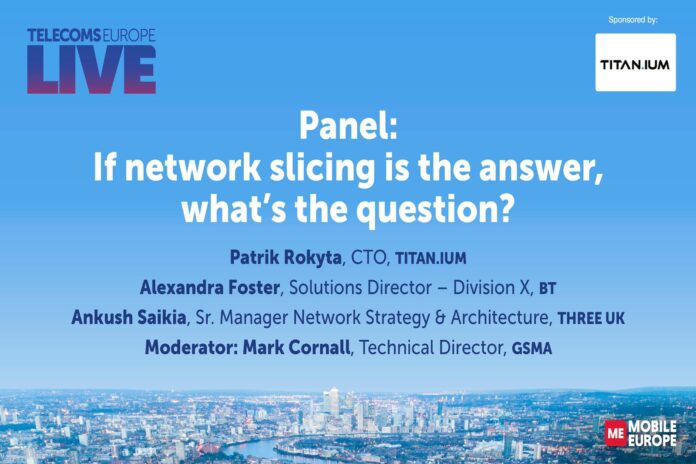Watch our expert panel debate the progress and value of network slicing at our Telecom Europe LIVE event in London
The session was moderated by Mark Cornall, Technical Director of the GSMA, with panellists Alexandra Foster, Solutions Director – Division X, BT, Patrik Rokyta, CTO of TITAN.IUM, and Ankush Saikia, Senior Manager Network Strategy & Architecture at Three UK.
The discussion covered a lot of ground. It began with Ankush Shaikia, Senior Manager Network Strategy & Architecture at Three UK noting that, “The issue with 5G private networks is that they are expensive [and] not scalable. They work for trials and a test, but when you try to scale up to hundreds of 5G networks, it’s not a commercially viable solution.
“We need a cost-effective operational effective solution to provide guarantee of service to the enterprise and network slicing is an answer. It is still in a very nascent stage but developing.”
The need to be viable
Patrik Rokyta, CTO of TITAN.IUM, pointed out that while much thought had gone into bringing network slicing into the first 5G networks, “it simply didn’t happen”. He is more hopeful of progress with 5G core to address more and more verticals, at economic prices. He also feels the rise of AI is a critical success factor too.
He highlighted use cases in the health sector and how different applications need different, dedicated QoS characteristics: monitoring someone recovering from a hip operation and ensuring they haven’t fallen is very different from keeping an eye on someone’s heart beat or blood pressure. He added, “On top of [suitable guaranteed parameters] they want to have this network to be secure – they handle really sensitive data. When you have an offering that can deliver both the QoS and a highly secure network, then I believe that such use cases are perfectly viable.”
He continued, “Enterprises run their own business, they don’t care about networks [although] they first think about security. They don’t want to deal with technology – 5G or anything – they have their own stuff to do.”
Outcomes trump tech
BT’s Alexandra Foster agreed with Rokyta’s view that customers don’t want to talk about technology. She said the real question is to find out what outcomes customers want and to figure out the best solution that makes the best use of assets like spectrum instead of starting with technology.
She added, that from the operator’s point of view “monetisation is about being able to offer different solutions for all of our customers [so they can] offer a smorgasbord of opportunities to their customers, and then starting to think about the onward models, [and] maybe a tenanting type model as well.”
She cited a number of possible use cases for network slicing, including broadcast. Shaikia added, “Dynamic network slicing is what will bring value to the customer and when it brings value to the customer, the operator benefits automatically. So the whole ecosystem is interlocked…and brings stability… It’s about making sure that everything works on an end-to-end bases. Customers need not only our technology to work, but they need other people’s technologies to work together – to really integrate and knit.”
Digging into the detail
From there the panel dug right into the technology, what needs to happen with functions like OSS monitoring, the importance of ecosystems, the importance of automation in provisioning and the potential for things to go wrong, the role AI can play in maintaining service level agreements, KPIs and a whole lot more.


